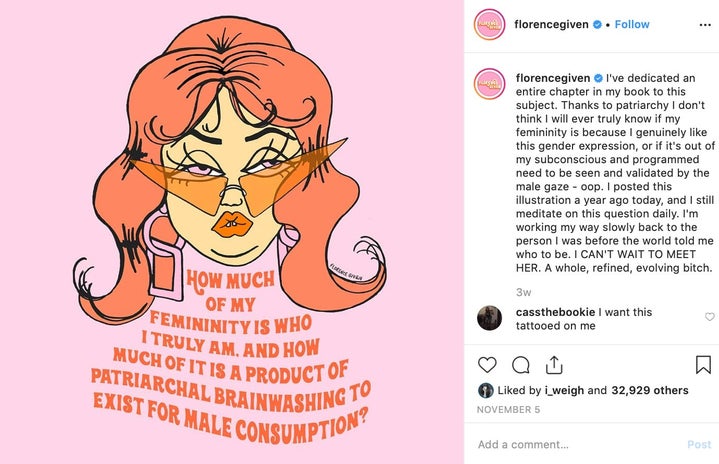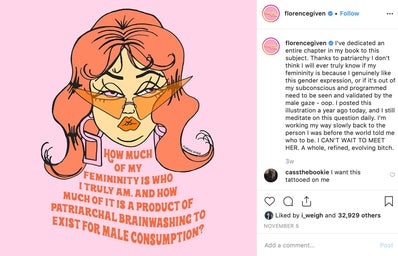The male gaze was coined by Laura Mulvey, in her essay “Visual Film and Narrative Cinema.” It is basically defined as the male fantasy, objectifying women in media and art. This is best understood with examples of some female characters in film usually never being involved in the action, never to the same extent as their male counterparts. If a woman contributes to the plot of the film, it usually only correlates with the main character’s arc or as a romantic/sexual interest. In many films, women characters are there to only fulfill the fantasies of male audiences. It is this continued, and normalized, the portrayal of women in so many movies that has allowed society to understand women as only existing for pleasure. We are not meant to really add to the story, that’s a man’s job. When we wake up in the morning, it has to be with a full face and hair done. We can’t add to the plot as just a character with her own background, we have to sprinkle in romance with the main (often male) character.
We’ve seen these movies, with Black Widow barely getting her own film in 2021 after years of being a side character that, for some reason, is prone to taking down enemies with her thighs. There’s also Megan Fox, an actress who has been extremely open with how she was typecasted and sexualized by Hollywood, forced to only take on roles that fulfill the male gaze. Many of these movies, like the Marvel or Transformer’s movies, are known to being male-centered. So, it seems obvious to movie executives that a male audience is where the money is at. Even in cinema that can be attempting to empower women, it’s not hard to find a scene that can seem obviously thrown in there to cater to a male audience. Like, if a woman is placed in “reverse roles”, and being the main character, they are still wearing tight-clothing or just unrealistic clothing in general. Why does Wonder Woman need to wear wedges into battle? Why does she need to wear boob armor? She’s the main character, surely, she could wear a better outfit that would suit the battle better. But it’s because that, despite being a female character being placed in a reverse role, she is still catering to the male audience watching the movie. But, when a woman watches the movie, one of the first things we think of is, “Why is she wearing heels to battle?”
The female gaze is not the reverse of the male gaze, instead, it shows the world how a woman would view it. These scenes usually show what it is like to be objectified, the emotions of women, and the issues they often deal with. In the male gaze, a main point is that the audience is viewing the female character from the outside, being, well, the audience. The female gaze has the audience placed in the shoes of the female character. It is meant to show the complicated lives of women, a world where they can be the main character and not be just a beautiful object to be stared at while she kicks ass.
One of the best movies to portray the female gaze is Birds of Prey, which follows Harley Quinn as an individual, not just as a pretty object. There is a big focus on her mental health and her own personality following her breakup with the Joker. She no longer wears the scanty costumes from Suicide Squad, instead, she is wearing “realistic” clothes, that look comfortable to female audiences. That was the issue with Suicide Squad, as its the use of the male gaze is what harms women. As Ciara Wardlow from the Hollywood Reporter says, “When you’re a girl growing up caring about superhero movies and you see girls and women in those films treated in this fashion, it leaves a profound impression. It is not the existence of this gaze that does the damage but seeing it in constant repetition”.
A movie I recommend watching to understand the male gaze is the Virgin Suicides. This Sophia Coppola film follows a group of 5 sisters, who all commit suicide. The narrators are a group of boys, looking back on their childhood fascination with the girls, before and after their deaths. In this movie, the girls can barely be considered the main characters. Instead, since the narrative is through the boy’s eyes, the audience sees the sisters as beautiful, tragic, and objects. They ignore the trauma and pain the girls are very obviously going through, only focusing on the beauty they represent, creating an icky viewing experience. There is never a conversation with the boys asking the sisters how they feel, or what they think. They never seem like real girls, just characters the boys made up in their heads while watching them from afar.
It’s almost disturbing how it’s so easy to recognize the male gaze in so many movies after learning what it is. Now, I can’t help but notice that so many loved movies feature it in some way. Movies need to learn to deconstruct the male gaze and recognize that women don’t exist to be stared at. There needs to be better portrayals about women, about their lives, emotions, and sexuality. Society is reflected in movies and movies influence society through its representations, changing the audience’s opinions on a multitude of issues. Women are more than objects to look at, they can be beautiful, and have a story centered solely on them. They are more than the tropes movies have ingrained in society to view them as.



